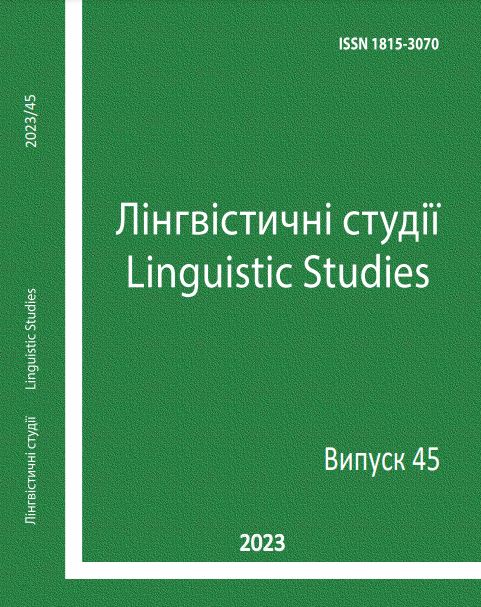War in the east of Ukraine through the eyes of students of Vinnytsia region and Donetsk region: associative dictionary (2014 - 2021)
DOI:
https://doi.org/10.31558/1815-3070.2023.45.15Keywords:
psycholinguistics; psycholinguistic analysis; language; thinking; armed conflict; associative dictionaryAbstract
The aim of the study is to compare linguopsychological portraits of students by geographical and chronological parameters, to compare language materials of students of the Donetsk region and students of the Vinnytsia region in the period from 2014 to 2021 with the disclosure of the main trends in the influence of the situation in the East of Ukraine on their speech and thinking through changes in the mental health of the student and to determine the levels of stress resistance and preparedness for the perception of the fact of hostilities to predict and/or model new forms of behavior and forecasting moral values unusual for modern youth in the future, to create an associative glossary.
References
Бочкор, Н.П., Дубровська, Є.В., Залеська, О.В. Соціально-педагогічна та психологічна робота з дітьми у конфліктний та постконфліктний період. Київ: МЖПЦ «Ла Страда-Україна», 2014. 84 c.
[Bochkor, N.P., Dubrovska, Ye.V., Zaleska, O.V. Sotsialno-pedahohichna ta psykholohichna robota z ditmy u konfliktnyi ta postkonfliktnyi period. Kyiv: MZhPTs «La Strada-Ukraina», 2014. 84 c.]
Жигай, А.С. Зміна світобачення дитини під час збройного конфлікту на сході України: лінгвопсихологічний аналіз. Лінгвокомп’ютерні дослідження: Донецький нац. ун-т ім. Василя Стуса 14, гол. ред. А. Загнітко. Вінниця: ДонНУ ім. Василя Стуса, 2021, 82–87.
[Zhyhai, A.S. Zmina svitobachennia dytyny pid chas zbroinoho konfliktu na skhodi Ukrainy: linhvopsykholohichnyi analiz. Linhvokompiuterni doslidzhennia: Donetskyi nats. un-t im. Vasylia Stusa 14, hol. red. A. Zahnitko. Vinnytsia: DonNU im. Vasylia Stusa, 2021, 82–87.]
Загородня, О. «Система опрацювання асоціативних результатів “STIMULUS”». Українська мова 2, 2018: 115–130.
[Zahorodnia O. «Systema opratsiuvannia asotsiatyvnykh rezultativ “STIMULUS” ». Ukrainska mova 2, 2018: 115–130.]
Мартінек, С. Український асоціативний словник: В 4-х т. Вид. 2-ге, стер. Львів: ПАЇС, 2008. Т. 1‒2: Від стимулу до реакції. Т. 1. 468 с.; Т. 2: 471 с.; Львів: ПАЇС, 2021. Т. 3‒4: Від реакції до стимулу. Т. 3. 544 с.; Т. 4. 648 с.
[Martinek, S. Ukrainskyi asotsiatyvnyi slovnyk: V 4-kh t. Vyd. 2-he, ster. Lviv: PAIS, 2008. T. 1‒2: Vid stymulu do reaktsii. T. 1. 468 s.; T. 2: 471 s.; Lviv: PAIS, 2021. T. 3‒4: Vid reaktsii do stymulu. T. 3. 544 s.; T. 4. 648 s.]
Терехова, Д.І. Особливості сприйняття лексичної семантики слів (психолінгвістичний аспект). Київ, 2000.
[Terekhova, D.I. Osoblyvosti spryiniattia leksychnoi semantyky sliv (psykholinhvistychnyi aspekt). Kyiv, 2000.]
Терехова, Д.І. «Урахування соціолінгвістичних чинників у психолінгвістичному дослідженні». Проблеми семантики слова, речення та тексту 22, 2009: 399‒411.
[Terekhova, D.I. «Urakhuvannia sotsiolinhvistychnykh chynnykiv u psykholinhvistychnomu doslidzhenni». Problemy semantyky slova, rechennia ta tekstu 22, 2009: 399‒411.]
Jung C. Studies in Word ‒ Association. New-York, 1919.


